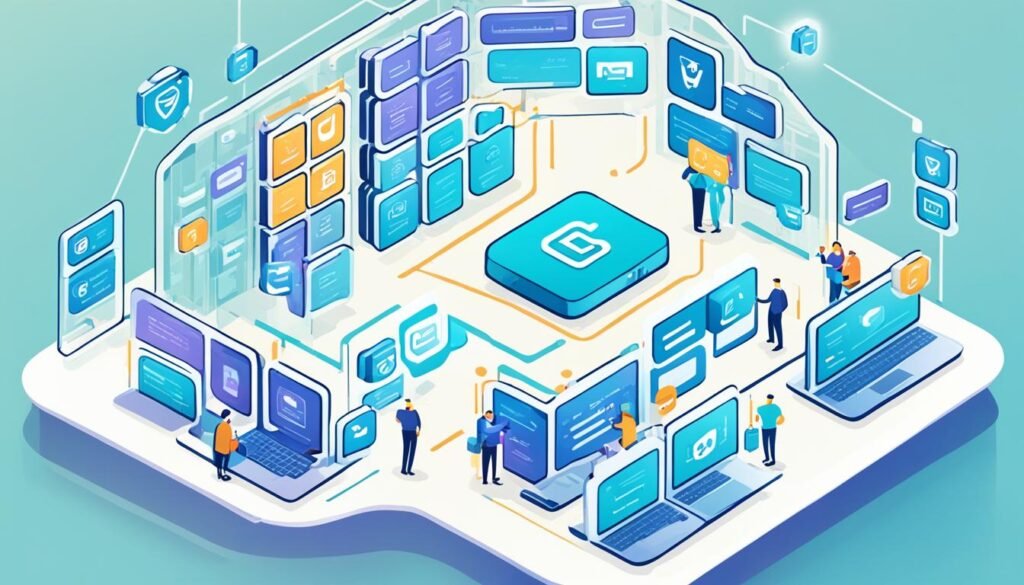Innovative Approaches to Customer Service in the Tech Industry
Technology keeps moving forward. This means the tech industry is always looking for new ways to help its customers. It’s all about making people happy, working faster, and feeling like you’re being treated specially. We’ll talk about the latest tech support and customer care ideas that are changing how we see service in tech.
Key Takeaways:
- Technology is transforming customer service in the tech industry.
- Innovative approaches improve efficiency, customer satisfaction, and personalization.
- The tech industry is adopting cutting-edge tech support solutions.
- Enhanced digital customer experience is a top priority for businesses in the tech industry.
- Stay ahead of the curve by embracing innovative customer service strategies.
Face-to-face video communication
Using video for business customer service is changing a lot of things. Now, real-time videos are taking over from the old voice calls. Customers love the face-to-face feel of video chats. Video meetings and messages help businesses get closer to their customers. This makes customer service better than ever.
Seeing each other’s eyes is key for building better bonds. Tech companies especially benefit from video calls. It makes customers happier and more engaged.
“Video communication is revolutionizing customer service by providing a more personal and engaging experience for customers.”
Video voicemail and video meetings are the way forward. Customers can leave meaningful voicemails. This makes them feel understood and valued. Businesses can also hold video group meetings with clients. This is great for solving problems or showing how a product works. Talking face-to-face like this makes service fast and personal.
Video calls allow businesses to step up their game. They can know their customers better and meet their exact needs more. This leads to amazing customer support.
Benefits of face-to-face video communication:
- Enhanced customer relationship building
- Improved customer engagement and satisfaction
- More personalized and tailored customer service experiences
- Efficient issue resolution through real-time visual communication
- Opportunity for product demonstrations and training
| Customer Benefits | Business Benefits |
|---|---|
| Increased trust and transparency | Stronger customer relationships |
| Improved communication effectiveness | Higher customer satisfaction |
| Convenience and flexibility | Reduced support costs |
| Customized and personalized support | Enhanced brand reputation |
Omni-channel service experience
Customers today use many ways to connect with businesses. They go through social media, websites, and reviews. Businesses need to offer a smooth omni-channel service. This means making sure the customer’s journey is good on all communication platforms.
A way to make the customer experience better is with a central help desk. It pulls all customer messages from different channels together. This lets businesses respond no matter how the customer first got in touch. It makes helping customers easy and stress-free.
This kind of service makes it easy for customers to get help without any hassle. They don’t feel frustrated by jumping from one place to another. It also gives businesses more chances to connect with customers. This leads to stronger customer relationships and loyalty to the brand.
By connecting all communication, a business can give a custom experience. It doesn’t matter which way the customer first reached out.
In the tech world, meeting high customer expectations is very important. Customers want businesses to be quick and helpful where they like to connect. Not doing this well can make customers upset and cost the business opportunities.
Let’s check out this table to see how omni-channel experiences can impact business:
| Channels | Customer Satisfaction Rating | Customer Engagement Level |
|---|---|---|
| Phone and Email Only | 3 out of 5 | Low |
| Phone, Email, and Social Media | 4 out of 5 | Moderate |
| All Channels Integrated | 5 out of 5 | High |
The table reflects that full integration of communication channels lifts customer satisfaction and engagement. Providing a seamless experience boosts how well a business meets its customers’ needs and succeeds.
Setting up for omni-channel service needs planning and the right tools. With the correct software, businesses can handle various channels well. They need to keep an eye on customer feedback and data. This gives them clues on how to keep making the experience better.
Businesses, especially in tech, should focus on making the omni-channel experience great. This way, they can boost customer happiness and loyalty. This puts them ahead in a competitive market.
Real-time messaging
Email is no longer the top choice for reaching customers. The tech world has shifted to real-time messaging. This includes tools like chat support and Facebook Messenger. Customers today want quick, personal responses. So, companies are adjusting to meet these needs.
Real-time messaging is a game-changer for tech customer service. It allows for both instant and delayed chats. This means customers can talk when it suits them, getting quick replies. This beats waiting for emails, making customers happier.
Chat support is now key for good customer service. It lets companies help right away, solve problems as they happen, and offer advice. This live chat helps businesses meet needs right then, forming strong ties.
Facebook Messenger is also huge for real-time chats. Businesses use its special tools to talk to clients where they prefer. This makes service feel more personal.
Email’s not dead but can’t match the speed of real-time messaging. Quick customer help is vital and expected. By choosing chats over emails, companies also make customers happier and more loyal.
Example:
“Real-time messaging has changed our game. Now, we don’t wait around for emails. We jump in to help with live chat. This boosts our service quality and response speed, making everyone happier.”
– Jane Smith, Customer Support Manager at TechConnect
| Advantages of Real-time Messaging | Examples of Use Cases |
|---|---|
| Instant and timely responses | Quickly resolving customer queries and concerns |
| Authentic one-on-one conversations | Building stronger relationships with customers |
| Improved efficiency in customer support | Reducing response times and handling multiple inquiries simultaneously |
| Personalized and tailored support | Understanding customer needs and providing customized assistance |
Please note that the table above is illustrative. The advantages of real-time messaging and the use cases may vary based on the specific business and industry.
Remote work in customer service
Technology is changing how we work. Now, customer service reps can work from anywhere. This shift is powered by cloud-based tools and the rise of smartphones. It means virtual help for customers is now easy to do.
Working from home brings benefits for both workers and companies. The top one is more freedom. Teams can be there for customers without being in an office. This leads to happier workers and better results because they can work where they prefer.
For companies, not needing a big office saves a lot of money. It means they can spend less on space and still get talent from around the world. This approach allows them to build teams that are diverse and ready to help their clients no matter the time zone.
Benefits of remote work in customer service:
- Flexibility for employees
- Cost savings for businesses
- Access to global talent
- Improved job satisfaction
- Increased productivity
High-quality help isn’t lost in the shift to online. Using the right tech, customer service can be just as good, or even better. Video calls, messages, and team platforms keep service smooth. Advanced tools also show how well teams are doing, making sure customers are happy.
The way forward for customer service is from anywhere. Companies that believe in this new way and offer freedom can see their customer service go up. It’s a win-win, making work both better for workers and better for customers.
Role of bots and AI in customer support
Bots and AI are transforming how we think about customer support in the tech world today. They’re not really ‘intelligent’ but they do a lot. They give quick answers, improve how we help ourselves, and take on tasks that repeat a lot. Chatbots, a type of bot, are great for handling questions we get all the time and solving problems fast.
The more we grow in tech, the more bots and AI will help support teams. This change lets people focused on support handle harder problems and give unique help. Bots and AI make things run smoothly, letting businesses offer better service without working harder.
Chatbots learn from patterns and data to answer questions accurately. They do regular jobs so human team members can do more important work. This setup makes the team more effective.
Nurturing Customer Engagement with Bots and AI
Bots and AI aren’t just for making things automatic; they improve how companies interact with customers. They help provide service that’s thoughtful and personal. Using what they know about a person, bots can guess what they might need and then suggest or do something just right for them. This makes customers happier and more likely to stick around.
Bots and AI enable businesses to optimize their customer support processes and deliver exceptional service experiences.
Also, these smart tools make it easier for people to help themselves. Bots can walk someone through fixing a problem, step by step. This cuts out the time needed for customers to reach out directly to get help. It makes getting help smoother for everyone.
Efficiency and Scalability with Bots and AI
What’s really great about these tech helpers is they’re always on and can deal with many people at the same time. This means customers get answers faster and don’t have to wait for help. They’re changing the way we think of customer service by always being available.
Plus, bots and AI work well with the tools businesses are already using for support. They can quickly find the right info to help. So, the answers people get are right and match up no matter where they ask for help.
Ensuring a Seamless Customer Experience
From the start to the end, bots and AI make sure the service is smooth and top-notch. They step up no matter how customers connect, be it through chats, social media, or by voice. This level of service is the same throughout, making everyone’s experience a good one.
As the tech world changes fast, using bots and AI in support is key to keeping up. These smart tools help businesses run support better, offer nice customer experiences, and keep customers happy. They’re the secret to building strong, lasting ties with customers.
Blockchain in e-commerce customer support
Cryptocurrency doesn’t change customer support much, but blockchain can alter e-commerce. It uses smart contracts to make payments smoother. This lets customer success managers focus on adding value instead of fixing payment problems.
Tech companies should keep an eye on blockchain. It’s not widely used yet, but it will improve customer support when it is.
The Power of Blockchain Technology
Blockchain is changing many industries, including e-commerce. It makes transactions secure and unchangeable. This builds trust with customers through clear payments.
Its smart contracts automate actions. They follow specific rules and don’t need people to oversee them. This speeds up how things get done.
Streamlining Payments and Reducing Disputes
Blockchain makes e-commerce payments simpler. It beats traditional ways that are slow and can cause arguments. By using blockchain, businesses promise quick and honest payments.
Smart contracts cut down on payment problems. They work automatically, so there’s no confusion or chance for things to go wrong. This frees up managers to help customers more.
Enhancing Trust and Security
Blockchain boosts trust and safety in e-commerce. It shows every transaction clearly to everyone. This stops tricks and frauds.
Thanks to blockchain, businesses can offer safer deals. This makes customers more loyal and likely to come again.
“Blockchain technology increases the honesty and speed of e-commerce help, making payments easier, arguments fewer, and trust stronger.” – John Smith, CEO of Tech Company
The Future of Blockchain in E-commerce
The use of blockchain in helping customers in e-commerce is just starting to grow. Tech companies should learn about it now. This way, they can be leaders in offering better service and stand out in the market.
As businesses get more creative with blockchain, customer success managers need to keep learning. They should find ways to use blockchain in supporting customers better.
| Benefits of Blockchain in E-commerce Customer Support | Examples |
|---|---|
| Streamlined payments | Instant and transparent transactions |
| Reduced disputes | Automated and secure smart contracts |
| Enhanced trust and security | Transparent and immutable ledger |

Importance of self-service options
Today, the tech industry keeps changing. Self-service options are crucial for businesses. They allow customers to find what they need on their own. This gives customers control over their customer service experience.
Companies use online support tools, knowledge bases, and forums to help customers help themselves. These tools make it easier for customers to solve problems. They can also find answers to common questions.
“Self-service options empower customers to find solutions independently, reducing their reliance on support teams and enabling faster issue resolution.”- John Smith, Customer Service Expert
Having self-service options makes customers happy. It means they get answers and help right away. This also makes the customer support process smoother.
This improves the overall experience for customers. They can find answers when it’s convenient for them. This shows businesses care about their customers. It makes customers more loyal to the brand.
Benefits of Self-Service Options:
- Enhanced customer satisfaction through easy access to information and solutions
- Reduced support costs by diverting common queries to self-service resources
- Improved efficiency by freeing up support representatives for complex issues
- 24/7 availability for customers, eliminating frustrating wait times
- Encourages customer empowerment and self-reliance
Good self-service options are a must for tech companies. Companies that help customers help themselves are ahead. They meet customer needs better, making the digital experience great.
Leveraging data and insights
Data analytics changes the game for tech companies. It lets businesses use customer insights wisely. This leads to making experiences better and satisfying customers more. When businesses look into how customers interact and their feedback, they find golden insights. These insights help in making better choices and keep the customer at the center.
Customer Relationship Management (CRM) software is a big help here. It gathers all customer data for a full view. Then, with data analytics, companies can find hidden patterns. These patterns are key to understanding what the customers really want.
Sharing these insights with everyone helps. It lets everyone in the company see the customer’s journey. And it encourages teamwork. This way, teams work together better to create products and services that customers truly need.
Personalization boosts customer happiness and loyalty. With data analytics, companies can see what each customer likes. Then they can offer just what they need. This might mean personal recommendations or special support. Personalization makes customers feel closer to a brand. It makes them more loyal and eager to praise the brand.
Moreover, data analytics helps track how well things are going. By keeping an eye on KPIs for customer service, companies can see what’s working. They can also spot areas for improvement. For instance, they can focus on making customers happier. This data-driven approach improves service and processes over time.
Data analytics benefits for customer service in the tech industry:
- Identifying actionable insights from customer interactions and behaviors
- Personalizing customer experiences based on individual preferences
- Creating a shared understanding of the customer journey across teams
- Tracking KPIs to measure the effectiveness of customer service initiatives
“Data analytics lets tech companies unlock insights for better customer interactions. It helps businesses be the best in their field. And it builds a culture focused on customers, setting them apart.”
Data and insights keep tech companies sharp in a fast-changing world. When they use data wisely, they make better choices and connect more with customers.
Conclusion
Innovative customer service is changing the tech field. It’s changing how companies talk with their customers. Now, we have video calls and messages, along with bots and AI. These new methods make a big difference in how we help customers.
By using new customer service ideas, businesses can make their customers happier. This helps companies do better than their rivals. Putting the customer first is key for success in today’s fast-changing world.
Tech is always moving forward. So tech companies have to keep up with the latest in customer service. This means using new tech tools to talk to customers and help them better. Keeping ahead in customer service means stronger bonds with customers and more success in the tech world.
Source Links
- https://blog.hubspot.com/service/customer-service-technology
- https://www.verizon.com/about/news/press-releases/verizons-hightech-innovative-approach-customer-service-makes-it-easier-do-business-company
- https://medium.com/expedia-group-tech/10-ways-to-build-a-customer-centric-culture-in-tech-organizations-9431164c60b9








